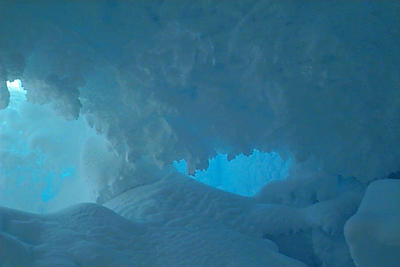7 November, 1998
November 7, 1998
One of the things I forgot to mention in yesterday's journal was
that our helicopter flight to Granite Harbor was cancelled because of
strong winds and a potential for weather change that might ground the
helicopters. This would leave us stranded out on the ice with only our
emergency gear and rations. So we opted to wait for a nicer day.
Yesterday was not a terribly exciting day. I worked in the
darkroom all day developing photos from the film I shot the day
before. These are photos of the chloride cells glowing from the
DASPEI stain. They really do look NEAT! But because the gill lamellae
are alive and thick, I can't get the whole thing in focus so the
photos are not very good. However they are good enough to use for
counting and measuring the chloride cells which I will probably start
to do today. The cells have to be counted and measured on the
photograph because in the microscope they die quickly and the
fluorescent stain seeps out into the surrounding tissue which makes
counting and measuring difficult. Even though it wasn't a very
exciting day, it was a very productive one. I got a good sense of
accomplishment since I am becoming more familiar with the procedures I
need to use. I also was taught how to unload the pictures from the
digital camera onto the computer so these photos should be appearing
soon.
Yesterday started out with a spectacular blue sky so I was
suprised to see that it was overcast when I emerged from the darkroom
at 12:45 for lunch. Some of the mountains across the frozen sea ice
were cloaked in ominous-looking clouds. It looked like we might get
snow, and the air didn't feel as dry as it usually does. It is still
the same today but there is no mention of snow in the forecast. Most
people think of Antarctica as a stormy land of ice and snow, but
actually, on a yearly basis, there is very little snow. Antarctica is
the driest continent. It is a cold desert. Here at McMurdo there are
only a few inches of snow each year. Some places in Antarctica
haven't received any snow for years.
QUESTION TO THINK ABOUT: If there is so little snow here each year
how could there have been enough snow to form the gigantic glaciers
that cover the continent and flow out into the frozen sea? These
glaciers are thousands of feet thick in some places. WOW!
Despite the clouds, the scene outside the window is still
wonderful! The clouds and patches of light that break through gaps in
the clouds enshroud the mountains giving it a mysterious look.
Today looks like it will be a pretty interesting day since we
have a fishing trip planned to the fish hut at Cape Evans. I passed my
driver's test yesterday so today I might be able to drive the spryte!
Well I hope you have a good day, and do something good for someone.
Seeya
Fred Atwood
_________________________________________________________
DO YOU YAHOO!?
Get your free @yahoo.com address at http://mail.yahoo.com

Content-Disposition: inline Trematomus bernacchii, the fish we are studying to find out how their gills control cell levels in the blood. I call them frog-faces.

A Weddell Seal basking in the sun at the foot of the Mt Erebus Glacier.

The entrance to the ice caves near the Mt Erebus Glacier

Inside the ice cave.
Contact the TEA in the field at
.
If you cannot connect through your browser, copy the
TEA's e-mail address in the "To:" line of
your favorite e-mail package.
|
